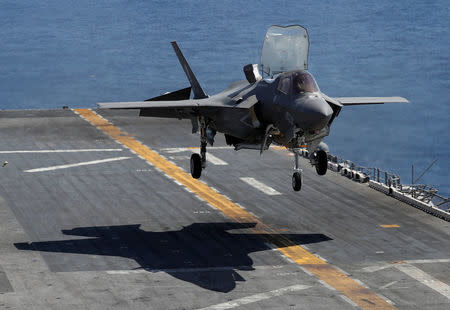U.S. showcases stealth fighter training on amphibious carrier

(This March 23 story corrects paragraph 4 quote to change word 'lead' to 'leap') By Nobuhiro Kubo ABOARD USS WASP, Philippine Sea (Reuters) - The U.S. military on Friday launched vertical take-off and landing (VTOL) F-35Bs from the deck of the USS Wasp amphibious carrier in the waters around Okinawa in its first show of stealth aircraft force at sea. The exercise comes at a time when concerns remain high over North Korea's nuclear program, although regional tension has eased in recent weeks, coinciding with the North's participation in the Winter Olympics held in South Korea last month. "This is a historic deployment. For the first time we take a marine stealth fighter F-35B. We pair it with a navy amphibious ship," Rear Admiral Brad Cooper, commander of the U.S. Navy's Expeditionary Strike Group 7, told reporters. "And together this represents what I believe is the most significant leap in war fighting capability of our lifetime ... It gives us more ability to underscore peace, security and stability in this region." During the training, an F-35B fighter took off after running just 100 meters (109 yards) or so on the deck, and when it came back with its jet engine roaring, the aircraft hovered over the ship once, and then began its slow, vertical descent. It is capable of a vertical, as well as short takeoff. In November, the United States deployed 16 F-35Bs to its Marine Corps base in Iwakuni, western Japan. The refurbished Wasp moved to its base in Sasebo on Japan's major southwestern island of Kyushu in January to replace the amphibious carrier that was deployed there. SIGNIFICANT UPGRADE While the U.S. Air Force version of the F-35 is already flying from bases in Japan, the addition of the F-35B to replace aging Harrier jump jets marks a significant upgrade to U.S. marine force capability around the East China Sea, where China is also bolstering its military. China already has one operational aircraft carrier, the second-hand Soviet-era Liaoning bought from Ukraine in 1998, and is carrying out tests on its first indigenously built carrier, launched last year and expected to enter service in 2020. Beijing is also modernizing its military with stealth aircraft and other new equipment, and plans to spend 1.11 trillion yuan ($176 billion) on its armed forces in 2018, more than three times as much as Japan and around a third of what the United States spends. Japan may also buy the F-35B, which it could fly from its two Izumo-class helicopters carriers with small improvements to the ships such as strengthening their decks against the 450 degree Celsius (842°F) heat blast from the F-35B's engine. "Changes to the Izumo could be completed within three months," said a retired senior commander of Japan's Maritime Self Defense Force (MSDF). He asked not to be identified because of the sensitivity of the topic. Japan, which has already ordered 42 F-35As, could also operate F-35Bs from islands along the Okinawa chain that skirts the edge of the East China Sea that don't have runways. "Using its stealth capabilities the F-35 could fly deep into North Korea or China to target mobile air defense batteries or ballistic missile launchers," said Bonji Ohara, senior fellow at Sasakawa Peace Foundation, a think-tank. Ohara also is a former MSDF captain. (Reporting by Nobuhiro Kubo; writing by Tim Kelly, Kiyoshi Takenaka; Editing by Gareth Jones)

